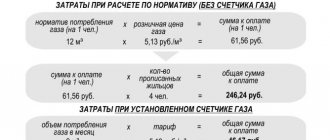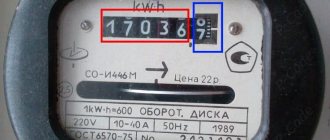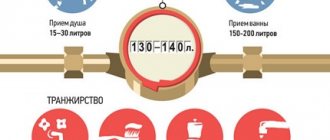It is necessary to transmit the data of an individual meter within a certain period of time. This ensures payment is calculated according to current tariffs. But in order to avoid discrepancies and errors, you need to correctly take the electricity meter readings. In fact, there is nothing complicated here, although not everyone knows where to look and which button to press to rewrite the necessary information.
Induction meters can be distinguished by a spinning wheel, which is located just below the frame with numbers. These numbers are the meter readings. The number of digits depends on the model.
How to take readings from an inductive and electronic electricity meter
How many numbers to write off
Typically, the induction meter display has 5, 6 or 7 digits. In most cases, the last digit, less often two, are separated by a comma, color, or differ in size. We do not take into account all numbers after the decimal point when taking readings . They show tenths and hundredths of a kilowatt and should not be taken into account. That is, we do not take into account all the numbers after the decimal point.
There are models with three “significant” digits and two after the decimal point
There are electricity meters that do not have decimal numbers. Then, when taking readings, write down all the numbers
But it is worth remembering that there are counter models that do not have a comma. In this case, when taking readings, you must write off all the numbers. If you don’t do this, sooner or later you will have to pay the difference, and it usually turns out to be very large. So be careful.
If you are unsure whether your meter has a comma, write down the model, name and call the customer service of the organization that supplies electricity. Let them clarify how many numbers in your case need to be written off when taking readings. You can also call an inspector to your home or check this data with the electrician of the management company.
How to shoot
Immediately after installing the meter, you were given a certificate in which the initial numbers are indicated. When you come to take readings from the light meter, take a piece of paper and copy down the current readings there (without taking into account the numbers separated by a comma). You can also not rewrite the zeros that appear at the beginning - up to the first digit (see photo).
Example of induction meter readings
For further calculations, data for the previous month is required. In the first month of use, you take them from the installation report, and in the future you need to either keep receipts or keep an accounting log. Where and how they will be stored is your choice.
Some subscriber services work in such a way that you don’t even need to count anything, you just need to transfer data within a certain period of time. Their automated system will write it to your personal account (or the operator will do it), then make the charges independently and generate a receipt. All you have to do is pay the invoice. But even in this case, for control, you can calculate how much you should pay for electricity yourself. Of course, it is unlikely that computers will make a mistake (they think), but you never know...
How to count
To calculate the electricity on the meter yourself, subtract the one that was there before from the number you just wrote. You get the number of kilowatts consumed over the last period.
For example, consider the readings in the photo above. Let the previous ones be 4852, the current ones 5101 (we ignore the numbers after the decimal point). We calculate the electricity consumption: 5101 - 4852 = 249 kW. To find out how much you need to pay, you need to multiply the resulting number of kilowatts (in this case 249 kW) by the tariff. Get the amount you have to pay for the light.
If the counter stands for a long time, sooner or later it will “reset to zero” - zeros will appear in the first positions. How to calculate electricity consumption in this case? Everything is very simple. This time you will have to rewrite the readings with all zeros, and put a “1” in front of the first one. For example, you asked to take readings from the meter, but only the last digits are different from zero. Or, as in the photo below, it costs only one.
After zeroing, there may be a picture like this, or there may be two digits other than zero, or three...
You rewrite the value as is, with all zeros (but we don’t write numbers after the decimal point), put a unit in front of the first zero, and then count as before. Let's count the readings in the photo. We write off the reading, putting “1” in front: 100001. Let the last reading be 99863. Subtract 100001 - 99863 = 138 kW. Total consumption for the reporting period was 138 kW. In the future, you write off the electric meter readings as before, without leading zeros and without substituting a unit.
Why do you need to calculate electricity?
To calculate the electricity consumption recorded by the electric meter, you will need to take readings from it twice.
Every month, the apartment owner must record readings from the electricity meter. Values are expressed in kilowatts per hour (kW/h). The recorded data must be shown to a full-time representative of the organization involved in energy supply, or the required amount must be calculated independently. The calculation is not difficult; in some meter models, for convenience, the required values are highlighted in color. A meter is installed at the entrance to the apartment and after the transformers.
How to notify an organization about energy costs:
- Come to the service office in person and report the readings taken.
- Send data via the Internet.
- Call the organization and dictate the information over the phone.
- Include readings in the column when paying receipts.
After this, the required amount is paid.
Taking readings
Electromechanical electricity meter
The algorithm for obtaining information from the meter depends on the device model. Nowadays old mechanical devices and modern electronic devices are used. Mechanical devices are single tariff, so when determining the amount for energy, complex calculations are not required.
How to calculate electricity using a meter from mechanical devices:
- The device has a dial with 5-7 digits. Each reel has values from 0 to 9. You need to write down the data to the decimal point - this is the energy consumed during the operation of the counter.
- The resulting value is transmitted to the network organization as received or subtracted from the previous value.
A number of counters are reset to zero when the maximum value is reached. In this case, before counting kilowatts on the meter as light, you need to add one (1 000001) to the new value (for example, 000001) before the zeros and subtract the previous value.
Electronic electricity meter
Obtaining data from new meters is significantly different from mechanical ones. Electronic metering devices are single-phase and three-phase. The main difference is the presence of an electronic display, which can be multi-tariff. To take readings correctly, you need to understand the features of the product. Single-tariff readings are not divided into zones, double-tariff readings are marked as T1/T2, and three-tariff readings are T1/T2/T3.
Algorithm for recording readings:
- Press the button on the device body. It is called “Input”, “Frame”, “PRSM”.
- Numbers appear on the screen. You need to look at the zone signatures - T1, T2, T3. This determines how electricity is calculated based on the average value.
- The main current indicators are recorded, consisting of 5-6 digits, up to the decimal point.
- The received data is sent to the appropriate organization.
Single-tariff devices display the total energy consumption. Two-tariff zones are divided into day zone T1 from 7:00 to 23:00 and night zone T2 from 23:00 to 7:00. Three-tariff tariffs are divided into peak zone T1, which has two time periods from 7:00 to 10:00 and from 17:00 to 21:00; night T2 from 23:00 to 7:00 and half-peak T3 alternating from 10:00 to 17:00 and from 21:00 to 23:00. The lengths may vary depending on the region where the meter is installed.
How to take readings from three-phase meters
There are two types of three-phase electricity meters - the old type, which requires transformers, and electronic direct connection (without transformers). If an electronic one is installed, the electricity meter readings must be taken in the same way as described above. Simply write down the values, wait until the necessary information is displayed on the screen, or “scroll” the data to the required page.
Connecting an electric meter in a three-phase network via current transformers
If a large amount of power is allocated or an old-style meter is installed, a transformer is installed on each of the phases. To take readings in this case, you need to know the transformation ratio. The readings taken must be multiplied by this coefficient. The resulting figure will be the actual expense.
But in general, you need to read the contract. The calculation procedure must be prescribed there - in some organizations they write out readings, put down the transformer data or transformation ratio, and the actual calculations are made by the operator himself. So, if you have a 3-phase meter, check the form and procedure for calculations when installing and sealing the metering device and putting it into operation.
Calculation of electricity by meter
An example of filling out a receipt
The correctness of the calculations depends on the correctness of the choice of tariff. It differs for regions, and will also be calculated depending on additional factors: type of settlement, rates at different times of the day, benefits, etc. You can find out the tariff for a specific home in different ways:
- On the website or at the service provider's office. All data is indicated on the stands. If the tariff increases, information can be found in the press and on the website of the commission dealing with electricity supply issues. The department’s website also offers an online calculator through which you can find out the fee for a specified period of time.
- Look on the receipt.
It is important to find out information about tariff increases from official sources. This will avoid errors in calculations.
Next, you can proceed to calculating the spent voltage and current. This is done differently depending on the type of device.
Calculation of a single-phase meter
Single-phase electricity meter CE 101 R5 220B
The difference between the values in the current and previous month is calculated. This value is multiplied by the established tariff.
Example: current readings are 000200, for the previous month 000150. The difference will be equal to 000200-000150=50 kW/h. Let the tariff be equal to 5 rubles per kW/h. Then the payment amount will be 50 * 5 = 250 rubles.
Calculation of a two-tariff device
Subtraction is performed in a similar way, but for each zone separately. Next, the resulting value is multiplied by the corresponding tariff. T1 needs to be multiplied by the peak zone tariff, T2 by the night tariff, which is lower in cost.
Calculation of a three-tariff metering device
Data is taken from three zones. The values for the previous month are subtracted from them. The corresponding readings are multiplied by a certain tariff.
An example of how to calculate light from a meter for a three-tariff device: T1 for the current month is 000400, T2 000350, T3 000550. For the previous month T1 000380, T2 000300, T3 000490. Then for the peak zone you need to pay (at a tariff of 6 r) 000400- 000380 = 000020* 6= 120 rubles. Per night (at a rate of 2 rubles) 000350 – 000300 = 000050 * 2= 100 rubles. For half-peak (with a tariff of 5 rubles) 000550 – 000490 = 000060 * 5= 300 rubles. All obtained values must be added: 120 + 100 + 300 = 520 rubles. This amount must be paid for the billing period.
There are several ways to cut costs. First of all, it is recommended to turn on powerful appliances at night at a reduced tariff. You should also replace all light bulbs in the house with energy-saving ones (LED, fluorescent).
Who is the owner of the kilowatt?
The conflict between gardeners and energy workers did not begin immediately. For ten years, the company did not check the equipment through which the gardening partnership received electricity. And when the old transformer was finally replaced, the power engineers presented the partnership with an exorbitant bill. Citizens refused to pay, and the company sued them for “unaccounted electricity consumption.”
The beginning of the story can be considered the moment when the sales company began supplying electricity to the newly created gardening partnership. And a decade later I came there to check the equipment. It turned out that it was outdated a long time ago and needed to be changed. Negotiations between SNT management and power engineers about replacing equipment went on for a long time and sluggishly.
As a result, the gardeners replaced the transformer themselves. For more than six months after this, the energy supply company received meter readings from SNT and issued invoices for payment of consumed electricity. And then, seven months later, I suddenly noticed that there were no seals on the new transformer. That’s when the power engineers demanded that gardeners pay for “unaccounted-for energy consumption” for several months. The amount put forward was a decent one - more than 1.2 million rubles.
The court considered the claim and rejected the energy sales company. But the appeal overturned this decision and adopted the exact opposite. The second instance decided that the absence of seals on the transformer evidenced the “unaccounted consumption of electricity” committed by the partnership. The gardeners were also blamed for not notifying the power engineers about the replacement of the transformer in writing.
The gardeners did not agree with this verdict and went all the way to the Supreme Court. They tried to prove that it was impossible to demand payment from them for unaccounted energy consumption. SNT explained that there were no seals on the old transformer, which had been working for ten years. All these years, the lack of seals did not bother the energy company. Energosbyt was not interested in the transformer for years and did not inspect the devices. And when the unit was changed, he issued bills to his subscriber for seven months.
The Supreme Court examined the materials of the dispute and overturned the decision of the appeal, upholding the decision of the first court, which denied the energy workers’ desire to receive more than a million rubles for “unaccounted electricity consumption.”
Cases regarding the correct charging of electricity bills are considered very common in our courts today. Energy companies began to actively issue bills to citizens and, in case of non-payment, demand fulfillment of obligations. Including through the courts.
Thus, recently the Supreme Court explained who the residents of an apartment building in Pskov will pay for electricity. In this building, after the termination of the contract with the management company, the supplier continued to supply the residents with electricity. And he did this without going through the management company. He demanded payment directly from the owners.
Residents of the house complained to the prosecutor's office. They wrote that they are charged for electricity for general household needs not according to the standard, but according to meter readings. The supervisory authority decided that the supplier’s actions were illegal. Prosecutors issued a statement to the former supplier, which he appealed in court.
The first instance sided with the energy workers. The second decided that after the termination of the contract with the management company, the energy sector became the direct executor of the utility service - the supply of electricity. For this reason, the company had the right, on its own behalf, to demand payment for electricity from residents.
The prosecutor's office, in turn, appealed this decision to the Supreme Court. Representatives of the supervisory agency explained: an organization can be the direct executor of a utility service and issue bills to citizens for electricity on its own behalf only under one condition. Only if the apartment owners agree to this at a general meeting. However, the residents of the apartment building did not hold such a general meeting, prosecutors emphasized.
According to the prosecutor's office, the absence of contractual relations between the management company and the energy retailer does not give the latter the right to collect payments directly from the residents of the house. The Supreme Court, after hearing the arguments of the parties, agreed with the position of the prosecutor's office.
In another similar dispute, the Supreme Court decided whether the management company should pay for electricity for common household needs if the owners pay for electricity directly to the resource supplying organization? This issue was decided by the courts in the Ulyanovsk region. There, power engineers supplied electricity to apartment buildings in the village. The company made calculations and issued receipts for payment to the owners. Including expenses for general household needs. Although the owners decided to enter into management agreements with another local company.
After the prosecutor's office intervened in the case, the power engineers recalculated the electricity charges and presented this local company with demands to pay for volumes exceeding the established standard. She refused.
Cases regarding payment for electricity are among the most common in our courts today.
The local court met the energy workers halfway. He said that the absence of a resource supply agreement is not a basis for exempting this company from paying for energy. And if property owners pay utility bills directly to energy companies, this does not relieve the company from the obligation to pay for supplied resources that are not payable by consumers.
The appeal overturned this decision. Energy workers went to the Supreme Court. They said that the appeal had no grounds to exempt the company that manages the apartment buildings from paying for electricity supplied by the company for general house needs in an amount exceeding the consumption standard for this service. The Supreme Court said the first instance decision was correct.
General house needs
Receipt for electricity
The total amount in the receipt may vary. It may be increased by additional expenses. This is due to the fact that a fee is charged for general household needs. These include fees for lighting in the entrance, on the site, lamps in the attic, in the elevator, and built-in parking. All energy that is spent on illumination and maintenance of the house is divided among the residents and added to the receipt in the ODN column. The rate for general house energy was established by Law No. 307 of 2006 and was the same for everyone. Further, after the release of resolution No. 344 in 2013, the fee is calculated depending on the area of the apartment.
Payment is calculated as the square footage of a certain apartment divided by the area of the house. The resulting coefficient determines the amount that the apartment owner must pay.









